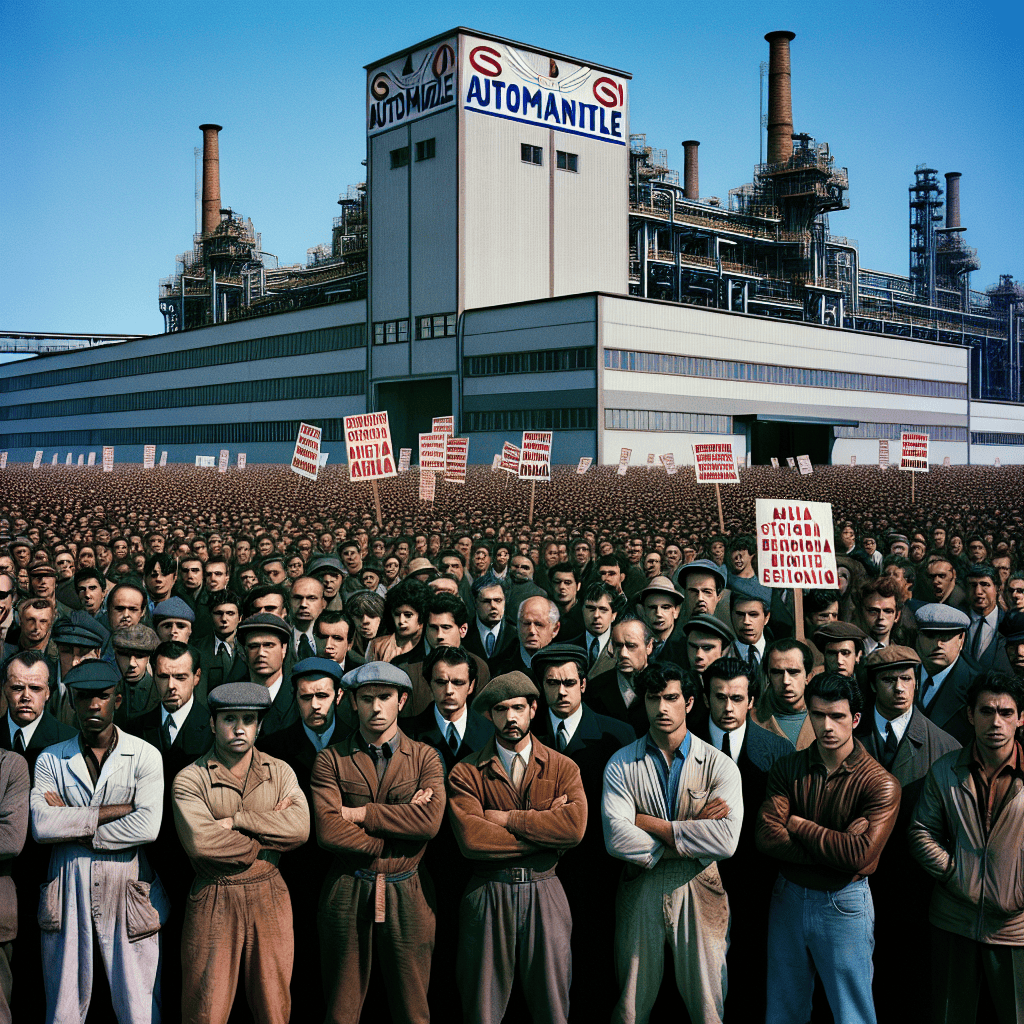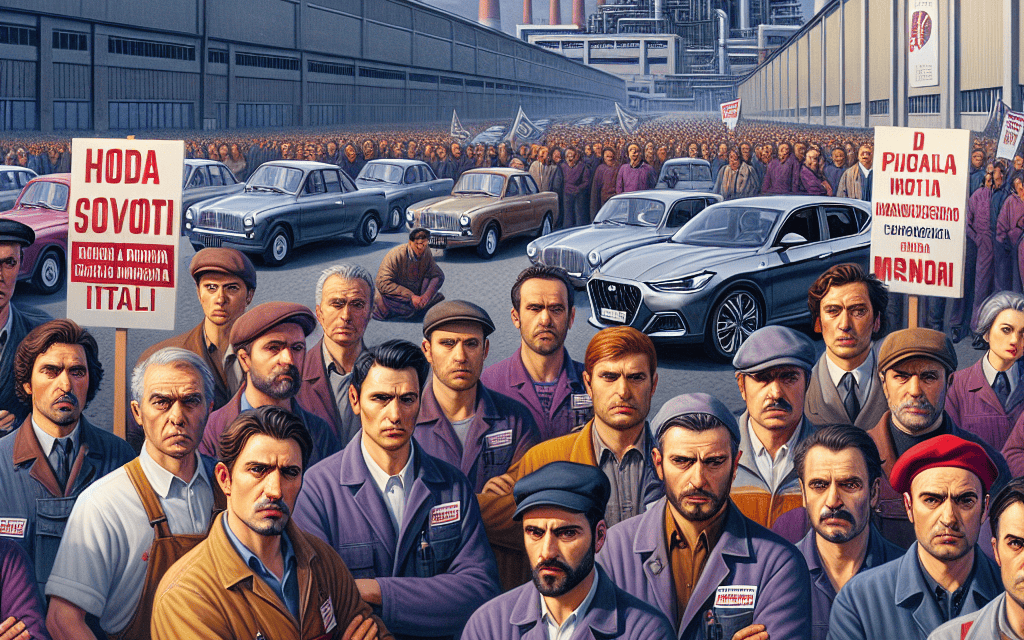“Unity in Motion: Italian Autoworkers Drive Change Amid Stellantis Struggles”
Introduction
In recent developments, Italian autoworkers have initiated a strike in response to escalating production challenges faced by Stellantis, one of the world’s leading automotive manufacturers. This industrial action underscores the growing tensions within the automotive sector, as workers demand better working conditions and job security amidst a backdrop of supply chain disruptions and evolving market demands. The strike highlights the critical intersection of labor rights and corporate strategy, as Stellantis navigates the complexities of maintaining production efficiency while addressing the concerns of its workforce. As the situation unfolds, the strike not only impacts Stellantis’ operations in Italy but also raises broader questions about the future of automotive manufacturing in an era of rapid technological and economic change.
Impact Of The Italian Autoworkers Strike On Stellantis Production
The recent strike by Italian autoworkers has cast a significant shadow over Stellantis, one of the world’s leading automotive manufacturers. This industrial action, primarily driven by concerns over job security, working conditions, and wage disparities, has emerged at a critical juncture for Stellantis, which is already grappling with production challenges. As the strike unfolds, its impact on Stellantis’s production capabilities becomes increasingly evident, raising questions about the company’s ability to navigate these turbulent times.
To understand the implications of the strike, it is essential to consider the broader context in which Stellantis operates. Formed from the merger of Fiat Chrysler Automobiles and PSA Group, Stellantis has been striving to streamline operations and enhance efficiency across its global network. However, the company has faced numerous hurdles, including supply chain disruptions, semiconductor shortages, and fluctuating demand in key markets. These challenges have already strained Stellantis’s production capacity, making the timing of the strike particularly problematic.
The strike, which involves thousands of workers across several Italian plants, has led to a significant slowdown in production. With assembly lines halted and output reduced, Stellantis is experiencing delays in meeting its production targets. This disruption is not only affecting the company’s ability to fulfill existing orders but also hindering its efforts to launch new models and expand its market presence. Consequently, the strike poses a threat to Stellantis’s competitive position in the automotive industry, where timely delivery and innovation are crucial.
Moreover, the strike highlights underlying tensions between Stellantis management and its workforce. Workers have expressed dissatisfaction with the company’s approach to labor relations, citing concerns over job cuts and the outsourcing of certain functions. These grievances have been exacerbated by Stellantis’s focus on cost-cutting measures, which, while aimed at improving profitability, have left many employees feeling undervalued and insecure about their future. The strike, therefore, serves as a manifestation of these deeper issues, underscoring the need for Stellantis to address employee concerns and foster a more collaborative working environment.
In addition to its immediate impact on production, the strike also carries potential long-term consequences for Stellantis. Prolonged industrial action could lead to a loss of consumer confidence, as customers may seek alternatives from competitors with more stable supply chains. Furthermore, the strike could strain relationships with suppliers and dealers, who rely on Stellantis’s ability to deliver products on time. These factors could ultimately affect the company’s financial performance, as disruptions in production and sales translate into reduced revenues and profitability.
In response to the strike, Stellantis has initiated negotiations with labor unions in an effort to reach a resolution. The outcome of these discussions will be pivotal in determining the company’s ability to restore normal operations and mitigate the strike’s impact on production. However, achieving a satisfactory agreement will require Stellantis to balance its financial objectives with the legitimate concerns of its workforce. By addressing these issues constructively, Stellantis can not only resolve the current crisis but also lay the groundwork for a more sustainable and harmonious relationship with its employees.
In conclusion, the Italian autoworkers’ strike presents a formidable challenge for Stellantis, compounding existing production difficulties and highlighting the need for improved labor relations. As the company navigates this complex landscape, its ability to effectively manage the strike’s impact will be crucial in maintaining its position in the competitive automotive industry. Through constructive dialogue and a commitment to addressing employee concerns, Stellantis can emerge from this crisis stronger and more resilient, poised to capitalize on future opportunities.
Historical Context Of Labor Strikes In The Italian Automotive Industry
The Italian automotive industry has long been a cornerstone of the nation’s economy, with its roots tracing back to the early 20th century. Over the decades, it has not only contributed significantly to Italy’s GDP but also played a pivotal role in shaping the country’s industrial landscape. However, this sector has also been a hotbed for labor strikes, reflecting the ongoing tensions between workers and manufacturers. The recent strike by Italian autoworkers amid Stellantis’ production challenges is a continuation of this historical pattern, underscoring the persistent issues that have plagued the industry for years.
To understand the current situation, it is essential to delve into the historical context of labor strikes within the Italian automotive industry. The post-World War II era marked a period of rapid industrialization in Italy, with automotive giants like Fiat leading the charge. During this time, labor strikes became a common occurrence as workers sought better wages, improved working conditions, and job security. The 1960s and 1970s, in particular, were characterized by widespread labor unrest, with autoworkers frequently clashing with management over these issues. These strikes often resulted in significant disruptions to production, highlighting the power of organized labor in the industry.
As the decades progressed, the Italian automotive industry faced new challenges, including globalization and increased competition from foreign manufacturers. These factors necessitated a shift in production strategies, often leading to cost-cutting measures that adversely affected workers. Consequently, labor strikes continued to be a tool for workers to voice their grievances and demand fair treatment. The formation of Stellantis, a multinational automotive corporation resulting from the merger of Fiat Chrysler Automobiles and the French PSA Group, has added another layer of complexity to the labor dynamics in Italy.
The recent strike by Italian autoworkers at Stellantis is emblematic of the ongoing struggles within the industry. Workers have expressed concerns over job security, particularly in light of Stellantis’ plans to streamline operations and focus on electric vehicle production. This transition, while necessary for the company’s long-term sustainability, has raised fears of job losses and changes in working conditions. The strike serves as a reminder of the delicate balance that must be maintained between innovation and the welfare of the workforce.
Moreover, the strike highlights the broader socio-economic issues facing Italy, including high unemployment rates and economic stagnation. In this context, labor strikes are not merely about immediate grievances but also reflect deeper anxieties about the future of work in the country. The Italian government, therefore, plays a crucial role in mediating these disputes and ensuring that the interests of both workers and manufacturers are addressed.
In conclusion, the historical context of labor strikes in the Italian automotive industry provides valuable insights into the current situation at Stellantis. While the industry has evolved over the years, the fundamental issues of worker rights and job security remain as relevant as ever. As Italy navigates the challenges of the modern automotive landscape, it is imperative to learn from the past and foster a collaborative environment that supports both innovation and the well-being of its workforce. The recent strike is a testament to the enduring power of labor movements and their ability to shape the future of the industry.
Economic Implications Of The Strike For Stellantis And The Italian Economy
The recent strike by Italian autoworkers at Stellantis has brought to light significant economic implications for both the company and the broader Italian economy. As workers demand better wages and improved working conditions, the strike underscores the growing tension between labor forces and multinational corporations in an era of economic uncertainty. Stellantis, formed from the merger of Fiat Chrysler Automobiles and PSA Group, is a key player in the global automotive industry. Consequently, any disruption in its operations can have far-reaching effects, not only on its production capabilities but also on the economies of the countries where it operates.
The strike, which has seen thousands of workers walk out of factories, comes at a time when Stellantis is already grappling with production challenges. These challenges are largely due to the global semiconductor shortage, which has severely impacted the automotive sector. As a result, the company has been forced to scale back production, leading to delays in vehicle deliveries and a potential loss of market share. The strike exacerbates these issues, as halted production lines mean further delays and financial losses. For Stellantis, the immediate economic implication is a decrease in output, which directly affects its revenue streams. The company must now navigate the dual challenge of addressing worker grievances while also managing supply chain disruptions.
Moreover, the strike has broader implications for the Italian economy, which is still recovering from the impacts of the COVID-19 pandemic. The automotive industry is a significant contributor to Italy’s GDP, and any prolonged disruption can have a ripple effect on related sectors, such as parts suppliers and logistics companies. The strike not only threatens the stability of these sectors but also poses a risk to employment levels, as prolonged industrial action could lead to job losses if companies are unable to sustain operations. Additionally, the strike highlights the delicate balance between maintaining competitive labor costs and ensuring fair compensation for workers. As Italy seeks to attract foreign investment and bolster its industrial base, labor unrest could deter potential investors who may perceive the country as a less stable environment for business operations.
Furthermore, the strike raises questions about the future of labor relations in Italy and across Europe. As companies like Stellantis continue to expand and integrate operations across borders, there is an increasing need for harmonized labor policies that can address the concerns of workers while supporting corporate growth. The outcome of the strike could set a precedent for future negotiations, influencing how labor disputes are resolved in the automotive industry and beyond. It also underscores the importance of dialogue between labor unions and management to find mutually beneficial solutions that can prevent such disruptions in the future.
In conclusion, the Italian autoworkers’ strike at Stellantis presents significant economic challenges for both the company and the Italian economy. While Stellantis must address immediate production issues and worker demands, the broader implications of the strike highlight the need for a balanced approach to labor relations that can support economic growth while ensuring fair treatment for workers. As the situation unfolds, it will be crucial for all stakeholders to engage in constructive dialogue to mitigate the economic impact and pave the way for a more stable industrial environment.
Worker Demands And Negotiation Tactics In The Italian Autoworkers Strike

The recent strike by Italian autoworkers has brought to light the complex dynamics between labor demands and corporate strategies within the automotive industry. As Stellantis, a major player in the global automotive market, grapples with production challenges, the demands of its workforce have taken center stage. The strike, which has garnered significant attention, underscores the critical role of negotiation tactics in resolving labor disputes and ensuring the sustainability of production operations.
At the heart of the strike are the workers’ demands for improved wages, better working conditions, and job security. These demands are not new; they echo longstanding grievances that have been exacerbated by recent economic pressures and the evolving landscape of the automotive industry. The workers argue that despite Stellantis’s robust financial performance, their compensation has not kept pace with inflation and the rising cost of living. Moreover, the shift towards electric vehicles and automation has heightened concerns about job security, prompting calls for retraining programs and assurances against layoffs.
In response to these demands, Stellantis has emphasized the need for flexibility and cost-efficiency to remain competitive in a rapidly changing market. The company has pointed to global supply chain disruptions and semiconductor shortages as significant challenges that have impacted production schedules and financial forecasts. Stellantis argues that meeting the workers’ demands without compromising on these fronts requires a delicate balance, one that necessitates open dialogue and mutual understanding.
Negotiation tactics have thus become pivotal in this standoff. The autoworkers, represented by powerful unions, have employed a range of strategies to amplify their voices and press for concessions. Strikes, work stoppages, and public demonstrations have been instrumental in drawing attention to their plight and rallying public support. These tactics are designed not only to disrupt production but also to highlight the indispensable role of the workforce in the company’s success.
On the other hand, Stellantis has sought to engage in constructive negotiations, offering incremental wage increases and proposing collaborative efforts to address job security concerns. The company has also highlighted its investments in new technologies and sustainable practices as part of its commitment to long-term growth and workforce development. However, these proposals have been met with skepticism by the workers, who demand more immediate and tangible benefits.
As negotiations continue, both parties are acutely aware of the broader implications of the strike. For Stellantis, prolonged disruptions could jeopardize its market position and erode investor confidence. For the workers, the outcome of the negotiations will set a precedent for labor relations in the industry, influencing future bargaining power and employment conditions.
In conclusion, the Italian autoworkers’ strike at Stellantis serves as a microcosm of the challenges facing the automotive industry today. It highlights the intricate interplay between worker demands, corporate strategies, and external economic factors. As both sides navigate this complex landscape, the importance of effective negotiation tactics cannot be overstated. Ultimately, the resolution of this strike will depend on the ability of both parties to find common ground and forge a path forward that addresses the needs of the workforce while ensuring the company’s competitiveness in a rapidly evolving market.
The Role Of Unions In The Italian Autoworkers Strike Against Stellantis
The recent strike by Italian autoworkers against Stellantis has brought to the forefront the significant role that unions play in advocating for workers’ rights and addressing production challenges within the automotive industry. As Stellantis, a global automotive giant formed from the merger of Fiat Chrysler Automobiles and PSA Group, grapples with production issues, the involvement of unions has become increasingly crucial in navigating the complexities of labor relations and ensuring fair treatment for workers.
Unions have long been a cornerstone of labor movements, particularly in Italy, where they have historically wielded considerable influence in negotiating better working conditions, wages, and benefits for employees. In the case of Stellantis, the unions have been instrumental in voicing the concerns of autoworkers who are facing the brunt of production slowdowns and operational adjustments. These challenges have been exacerbated by global supply chain disruptions and the ongoing transition towards electric vehicles, which have necessitated significant changes in production processes and workforce requirements.
The strike, which has seen thousands of workers walk out in protest, underscores the unions’ role as a critical intermediary between the workforce and management. By organizing collective action, unions aim to pressure Stellantis into addressing the grievances of its employees, which include job security, fair compensation, and safe working conditions. Moreover, the unions are advocating for a more transparent dialogue with the company to ensure that workers are adequately informed and involved in decisions that directly impact their livelihoods.
In addition to addressing immediate concerns, the unions are also focused on the long-term implications of Stellantis’ strategic decisions. As the company shifts its focus towards electric vehicle production, there is a growing need for reskilling and upskilling the workforce to meet the demands of new technologies. Unions are pushing for comprehensive training programs and support systems to facilitate this transition, ensuring that workers are not left behind in the rapidly evolving automotive landscape.
Furthermore, the unions’ involvement in the strike highlights the broader socio-economic context in which these labor disputes occur. Italy’s economy, like many others, has been significantly affected by the COVID-19 pandemic, leading to increased unemployment and economic uncertainty. In this environment, the role of unions becomes even more vital as they strive to protect workers’ rights and prevent further erosion of job security and income stability.
As negotiations between Stellantis and the unions continue, the outcome of the strike will likely have far-reaching implications for labor relations within the automotive industry. A successful resolution could set a precedent for how companies and unions can collaborate to address production challenges and workforce needs in a rapidly changing market. Conversely, a prolonged dispute could exacerbate tensions and disrupt production further, highlighting the need for effective communication and cooperation between all parties involved.
In conclusion, the Italian autoworkers’ strike against Stellantis serves as a poignant reminder of the essential role that unions play in advocating for workers’ rights and navigating the complexities of modern labor relations. As the automotive industry continues to evolve, the collaboration between unions and companies will be crucial in ensuring that workers are not only protected but also empowered to thrive in an increasingly dynamic and challenging environment.
Comparative Analysis Of Labor Strikes In The Global Automotive Sector
The recent strike by Italian autoworkers at Stellantis has brought to light the broader challenges faced by the global automotive sector, particularly in terms of labor relations and production efficiency. This event is not isolated but rather part of a larger pattern of labor unrest that has been observed across various countries, each with its unique set of circumstances and implications. To understand the significance of the Italian strike, it is essential to compare it with similar labor actions in other parts of the world, thereby gaining insights into the commonalities and differences that characterize these industrial disputes.
In Italy, the strike at Stellantis was primarily driven by concerns over job security, working conditions, and the future of automotive production in the country. Workers expressed fears about potential job losses due to automation and the shift towards electric vehicles, which require fewer labor-intensive processes. This anxiety is not unique to Italy; it echoes sentiments in other countries where the automotive industry is undergoing significant transformation. For instance, in the United States, the United Auto Workers (UAW) have similarly raised alarms about the impact of technological advancements on employment levels. The UAW has been vocal about the need for retraining programs and assurances that workers will not be left behind as the industry evolves.
Transitioning to another region, in Germany, labor strikes have also been a recurring theme, albeit with a slightly different focus. German autoworkers have often concentrated on negotiating better wages and benefits, leveraging the country’s strong tradition of collective bargaining. The German model of co-determination, where workers have a say in company decisions, has generally led to more collaborative relationships between management and labor. However, even in this relatively harmonious environment, tensions have arisen as companies face pressure to remain competitive in a rapidly changing market. The push towards electric vehicles and sustainable practices has necessitated significant investment, prompting companies to seek cost-cutting measures that sometimes conflict with labor interests.
Meanwhile, in Asia, the dynamics of labor strikes in the automotive sector present another layer of complexity. In countries like South Korea, strikes have often been characterized by their intensity and duration, reflecting a more confrontational approach to labor disputes. The Hyundai Motor Company, for example, has experienced numerous strikes over the years, with workers demanding better pay and working conditions. These strikes have occasionally led to significant production disruptions, highlighting the delicate balance between maintaining labor peace and achieving operational efficiency.
Despite the geographical and cultural differences, a common thread running through these labor strikes is the challenge of adapting to an industry in flux. The global shift towards electric vehicles, driven by environmental concerns and regulatory pressures, is reshaping the automotive landscape. This transition requires not only technological innovation but also a rethinking of labor practices and workforce management. As companies strive to remain competitive, they must navigate the complex interplay between technological advancement and labor relations.
In conclusion, the Italian autoworkers’ strike at Stellantis serves as a microcosm of the broader challenges facing the global automotive sector. By examining similar labor actions in other countries, it becomes evident that while the specifics may vary, the underlying issues of job security, working conditions, and the impact of technological change are universal. As the industry continues to evolve, finding a balance that addresses both the needs of workers and the demands of a competitive market will be crucial for ensuring sustainable growth and stability.
Future Prospects For Stellantis Post-Strike Resolution In Italy
The recent strike by Italian autoworkers has cast a spotlight on the challenges faced by Stellantis, one of the world’s leading automotive manufacturers. As the dust begins to settle, attention is now turning to the future prospects for Stellantis in the wake of this industrial action. The strike, which was primarily driven by concerns over job security and working conditions, has underscored the complexities of operating in a rapidly evolving automotive landscape. However, it also presents an opportunity for Stellantis to reassess its strategies and strengthen its position in the global market.
In the immediate aftermath of the strike, Stellantis is likely to focus on rebuilding trust with its workforce. This will involve addressing the grievances that led to the industrial action, such as ensuring job security and improving working conditions. By engaging in open and constructive dialogue with labor unions, Stellantis can foster a more collaborative relationship with its employees. This, in turn, could lead to increased productivity and a more motivated workforce, which are crucial for the company’s long-term success.
Moreover, the resolution of the strike provides Stellantis with an opportunity to reevaluate its production strategies in Italy. The automotive industry is undergoing a significant transformation, driven by the shift towards electric vehicles and the increasing importance of sustainability. Stellantis, like many of its competitors, is investing heavily in electric vehicle technology. By aligning its production facilities in Italy with this strategic focus, Stellantis can position itself as a leader in the transition to sustainable mobility. This could involve upgrading existing plants to accommodate the production of electric vehicles or even establishing new facilities dedicated to this purpose.
In addition to technological advancements, Stellantis must also consider the broader economic and regulatory environment in which it operates. The European Union’s stringent emissions regulations are pushing automakers to accelerate their transition to cleaner technologies. Stellantis, with its diverse portfolio of brands, is well-positioned to meet these challenges. By leveraging its global resources and expertise, the company can develop innovative solutions that comply with regulatory requirements while also appealing to environmentally conscious consumers.
Furthermore, the resolution of the strike could have positive implications for Stellantis’ market position. The automotive industry is highly competitive, and companies that can effectively navigate labor disputes and production challenges are likely to gain a competitive edge. By demonstrating its ability to resolve conflicts and adapt to changing circumstances, Stellantis can enhance its reputation as a resilient and forward-thinking company. This could translate into increased investor confidence and a stronger market presence, both in Europe and globally.
Looking ahead, Stellantis must also consider the potential impact of emerging technologies on its operations. The rise of autonomous vehicles and connected car technologies presents both opportunities and challenges for traditional automakers. Stellantis will need to invest in research and development to stay at the forefront of these innovations. By doing so, the company can ensure that it remains competitive in an industry that is increasingly defined by technological advancements.
In conclusion, while the recent strike by Italian autoworkers posed significant challenges for Stellantis, it also offers a chance for the company to reassess its strategies and strengthen its position in the global automotive market. By addressing labor concerns, aligning production with sustainable technologies, and embracing emerging innovations, Stellantis can navigate the complexities of the modern automotive landscape and secure a prosperous future.
Q&A
1. **What is the reason for the Italian autoworkers’ strike?**
The Italian autoworkers are striking due to disputes over wages, working conditions, and job security amid Stellantis’ production challenges.
2. **Which company is primarily affected by the strike?**
Stellantis, a major automotive manufacturer, is primarily affected by the strike.
3. **How has the strike impacted Stellantis’ production?**
The strike has led to disruptions in Stellantis’ production schedules, causing delays and potential financial losses.
4. **What are the demands of the striking workers?**
The striking workers are demanding better wages, improved working conditions, and assurances regarding job security.
5. **How has Stellantis responded to the strike?**
Stellantis has engaged in negotiations with union representatives to address the workers’ concerns and find a resolution.
6. **What role do unions play in the strike?**
Unions are organizing the strike, representing the workers’ interests, and negotiating with Stellantis for better terms.
7. **What are the potential long-term effects of the strike on Stellantis?**
The long-term effects could include strained labor relations, potential shifts in production strategies, and impacts on the company’s financial performance if the issues are not resolved.
Conclusion
The Italian autoworkers’ strike amid Stellantis production challenges highlights significant tensions within the automotive industry, particularly in the context of labor relations and production efficiency. The strike underscores the workers’ dissatisfaction with working conditions, job security, and wage issues, which are exacerbated by Stellantis’ ongoing production challenges, including supply chain disruptions and the transition to electric vehicles. This labor unrest not only threatens Stellantis’ operational stability in Italy but also reflects broader industry-wide challenges as automakers navigate the complexities of modernizing production while maintaining workforce satisfaction. The resolution of this strike will require careful negotiation to balance the needs of the workers with the strategic objectives of Stellantis, potentially setting a precedent for labor relations in the automotive sector.





